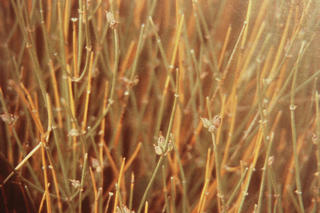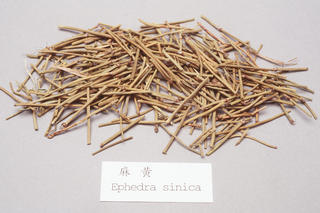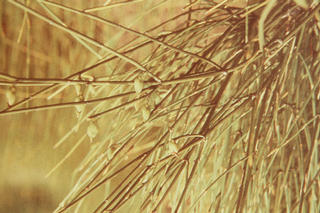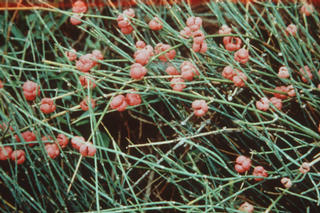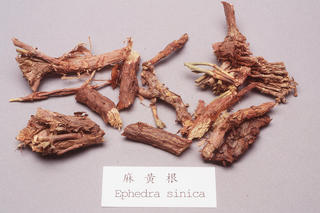Ephedra intermedia
Contents
Nomenclature
Other Names:
Historical Use of Ephedra intermedia
Ephedra intermedia in Traditional Chinese Medicine
Background
Shen Mahuang ÉúÂé»Æ
Zhi Mahuang ÖËÂé»Æ
Chinese Name (pinyin): Mahuang
Chinese Name :
Common Name :Ephedra
Specific Name : Herba ephedrae
Scientific Name:
Collection : The drug is collected in autumn and dried in the sun.
Description : Herb of Ephedra sinica: slenderly cylindrical, infrequently branched, 1 - 2mm in diameter. Some with a few brown woody stems. Externally pale green to yellowish green with fine longitudinal ridges, slightly rough. Nodes distinct, internodes 2 - 6cm long, scaly leaves on the nodes membranous, 3 - 4mm long with 2 lobes (rarely 3), acutely triangular, apex greyish white, reversed, base tubular and reddish brown in colour. Texture light, fragile and easily broken, fracture slightly fibrous with greenish yellow edge and subrounded reddish brown pith, odor slightly aromatic, taste astringent and slightly bitter.
Identification : (1) Transverse section of stemHerba Ephedra sinica: Epidermis covered with thick cuticle, ridges relatively dense with waxy warty protrudings and sunken stomata located between two ridges. Hypodermal fibre bundles located in ridges with walls thickened and unlignified. Cortex relatively broad, fibre bundles scattered. Pericycle fibre bundles crescent-shaped. Collateral vascular bundles 8 - 10. Cambium ring subrounded, xylem triangular. Pith parenchymatous cells containing brown masses, occasionally showing perimedullary fibres. Outer walls of epidermal cells, cortex parenxhyma cells and fibres all containing numerous fine sand crystal or prisms of calcium oxalate.Herb of Ephedra intermedia: Vascular bundles 12 - 15 Cambium ring subrectangular, Perimedullary fibres scattered in bundles or singly.Herb of Ephedra equisetina: Vascular bundles 8 - 10. Cambium ring subrounded, perimedullary fibres absent.(2) To 0.2g of the powder, add 5ml of water and 1 - 2 drops of dilute hydrochloric acid, boil for 2 - 3 minutes and filter. Transfer the filtrate to a separator, add several drops of ammonia TS to make alkaline and extract with 5ml of chloroform. Transfer the chloroform solution into two tubes. To one tube add ammoniated cupric chloride TS and carbon disulfide, 5 drops of each, shake well and allow to stand, the chloroform layer becomes deep yellow. To the other tube as a blank, add 5 drops of chloroform instead of carbon disulfide, shake well, the chloroform layer is colorless or slightly yellow.(3). To 1g of the powder add several drops of concentrated ammonia TS and 10ml of chloroform, heat under reflux for 1 hour and filter. Evaporate the filtrate to dryness. Add 2ml of methanol to the residue, mix well and filter. Use the filtrate as the test solution. To ephedrine CRS, add methanol to produce a solution containing 1mg per ml as the reference solution. Carry out the method for thin layer chromatography (Appendix Vl B), using silica gel G as the coating substance and chloroform-methanol-concentrated ammonia TS (20:5:0.5) as the mobile phase. Apply separately to the plate 5µl of each of the two solutions, after developing and removal of the plate, dry it in the air, spray with ninhydrin TS and heat at 105ºC for about 5 minutes. The spot in the chromatogram obtained with the test solution correspond in position and color to the spot in the chromatogram obtained with the reference solution.Assay: Weigh accurately about 5g of the fine powder into a Soxhlet's extractor, add 3ml of concentrated ammonia solution, 10ml of ethanol and 20ml of ether, allow to stand for 24 hours, add ether and heat under reflux on a water bath for 4 hours until complete extraction of the alkaloids is effected. Transfer the extract to a separator, wash the extractor with small quantity of ether and transfer the washing to the separator. Extract with hydrochloric acid (0.5mol/L) 20ml at first followed with 4 portion of 10ml each. Combine the acid solution, filter, add sodium hydroxide TS to make alkaline, saturate with sodium chloride and extract with 20ml and 4 portion of 10ml each of ether. Combine the ether extract, wash with three quantities, each of 5ml of saturated sodium chloride solution. Combine the washings and extract with 10ml of ether. Combine the above ether extracts, add accurately 30ml of sulfuric acid (0.01mol/L)VS, shake well, and allow the acid solution to separate on standing. Wash the ether solution with 3 quantities, each of 5ml of water, combine the acid solution and water washings, heat on a water bath to remove the trace of ether and allow to cool. Titrate with sodium hydroxide (0.02mol/L) VS, using 2 drops of methyl red IS. Each ml of sulfuric acid (0.01mol/L) VS is equivalent to 3.305mg of ephedrine C10H15NO. It contains not less than 0.80% of total alkaloids, calculated as ephedrine (C10H15NO).Processing: Remove the woody stems, roots and foreign matter and cut into sections.
Processing : Remove the woody stems, roots and foreign matter and cut into sections.Processed with honey: Stir fry the sections as describe under the method for stir frying with honey (Appendix ll D) until it is no more sticky to fingers, using 20kg of refined honey per 100kg of Herba ephedrae.
Action : To induce persipration for dispelling cold, to relieve asthma, and to cause diuresis.
Indication : common cold with wind-cold syndrome (marked by chilliness and mild fever, headache, stuffed or running nose, general aching, but no sweating); edema in acute neprhritis; bronchial asthma;
processed with honey: cough in common cold at later stage when chilliness has been absent
Precautions :
Dosage : 2 to 9 g.
Storage : Preserve in a ventilated and dry place, protected from moisture.
Nomenclature
Other Names:
Historical Use of Ephedra intermedia
Ephedra intermedia in Traditional Chinese Medicine
Background
Chinese Name (pinyin): Mahuanggen
Chinese Name :
Common Name :Ephedra Root
Specific Name : Radix ephedrae
Scientific Name:
Collection : The drug is collected in late autumn, removed from remains of stem, rootlets and soil and dried in the sun.
Description : Cylindrical, slightly curved, 8 - 25 cm long, 0.5 - 1.5 cm in diameter. Externally reddish brown or greyish brown with longitudinal wrinkles and scars of rootlets. The outer bark rough, easily exfoliated. Rhizomes with nodes, internodes 0.7 - 2 cm long, externally with transverse elongated, prominent lenticels. Texture light, hard and fragile, fracture yellowish-white in bark, pale yellow to yellow in wood showing radial rays with pith in the center. Odourless, taste slightly bitter.
Identification : Transverse section of the root: Cork consisting of about 10 or more layers of cells with rhytidome outside. Cortex consisting of several layers of parenchymatous cells, containing sand crystals of calcium oxalate. Pericycle consisting of fibres and stone cells. Phloem narrow, cambium in a ring. Xylem well developed, consisting of vessels, tracheids and xylem fibres. Rays broad containing sand crystal of calcium oxalate. Sometimes pith with fibres, parenchymatous cells with pits. Rays of rhizome relatively narrow.Powder: Brownish red or brownish yellow. Cork cells rectangular, brown containing sand crystals of calcium oxalate. Most fibres scattered singly, 20 - 25 µm in diameter, walls thickened and lignified with distinct oblique pits. Spiral and reticulate vessels, 30 - 50 µm in diameter, the perforated plate of the vessel members with numerous rounded pores. Stone cells, oblong, fibrous and branched. 20 - 50 µm in diameter, thick walled sometimes observed. Parenchymatous cells in pith subsquare, subrectangular or subrounded with slightly thickened with pits. Parenchymatous cells containing sand crystal of calcium oxalate.
Processing : Eliminate foreign matter, wash clean, soften thoroughly, cut into thick slices and dry.
Action : To arrest perspiration.
Indication : spontaneous sweating; night sweating
Precautions :
Dosage : 3 to 9 g; for external use, appropriate quantity to be ground into powder and dabbed on the skin.
Storage : Preserve in a dry place.
Synonymns for Ephedra intermedia
Patent Medicines and Medicines with Multiple Ingredients that include Ephedra intermedia
Pharmaceutical Information
Chemical Constituents
Evidence or the Use of Ephedra intermedia in the Treatment of Epilepesy
Basic Science
Animal Studies
Cohort, Case-Control and Non-Randomized Trials
Randomized Controlled Trials
Meta-Analysis
1st Five Results: pubmed search
Kengo Hayashi, Yuki Miyao, Hina Matsui, Takao Yamaura, Ken Tanaka, Mariko Baba, Hiroaki Hayashi
Comparison of Non-ephedrine Constituents from Ephedra Plants Cultivated in Japan.
Chem Pharm Bull (Tokyo): 2024, 72(4);385-388
[PubMed:38631893]
[WorldCat.org]
[DOI]
(I p)
Huayong Zhang, Jiangpeng Li, Hengchao Zou, Zhongyu Wang, Xinyu Zhu, Yihe Zhang, Zhao Liu
##Title##
Plants (Basel): 2024, 13(6);
[PubMed:38592953]
[WorldCat.org]
[DOI]
(P e)
Behnam Mahdavi, Sanaz Ebrahimi, Gholam Ali Farzi, Behrooz Maleki, Majid Mohammadhosseini
Ephedra intermedia Schrenk & C. A. Mey Methanol Extract: Nanoencapsulation by Mini-Emulsion Polymerization and its Release Trend under Simulated Conditions of the Human Body.
Chem Biodivers: 2024;e202400033
[PubMed:38488267]
[WorldCat.org]
[DOI]
(I a)
Xiling Fan, Yangang Cao, Mengnan Zeng, Yingjie Ren, Xiaoke Zheng, Weisheng Feng
##Title##
Molecules: 2024, 29(2);
[PubMed:38257345]
[WorldCat.org]
[DOI]
(I e)
Jiwon Park, Fahrul Nurkolis, Hyunji Won, Jiye Yang, Dayeon Oh, Hyunkyung Jo, Jinwon Choi, Sanghyun Chung, Rudy Kurniawan, Bonglee Kim
Could Natural Products Help in the Control of Obesity? Current Insights and Future Perspectives.
Molecules: 2023, 28(18);
[PubMed:37764380]
[WorldCat.org]
[DOI]
(I e)
